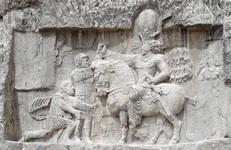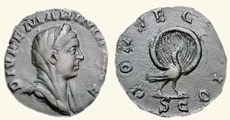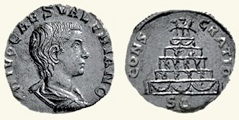Accession of Valerian and Gallienus (253 AD)
Valerian came from a senatorial family in Rome. He was proclaimed Augustus by the army in 253 AD and accepted as such by the Senate. His first act as Augustus was to make his son Gallienus his Caesar and colleague.
Valerian and Gallienus addressed the grave problems that faced them in both the east and the west of the Empire by splitting responsibility on a geographical basis.
Valerian in the East (253-60 AD)
Shapur with the imprisoned Valerian and (probably) the kneeling Emperor Philip (244-9 AD)
Naqsh-e Rustam (necropolis of Persepolis, modern Shiraz, Iran
Valerian enjoyed early successes, but his fortunes changed in 259 AD when he was based at Edessa. His army there was badly diminished by plague and the Persians under Shapur I besieged the city. Valerian was then decisively defeated in the Battle of Edessa in 260 AD. When Valerian attempted to negotiate peace, Shapur seized him and held him prisoner for the remainder of his life, thereby inflicting a traumatic humiliation on the Romans. According to Eutropius:
-
“Valerian, while he was occupied in a war in Mesopotamia, was overthrown by Sapor king of Persia, and being soon after made prisoner, grew old in ignominious slavery among the Parthians” (‘Breviarium historiae Romanae’, 9:7).
The humiliation heaped on Valerian was strongly felt across the Empire for decades. Thus The ‘Epitome de Caesaribus’:
-
“... Valerianus, waging war in Mesopotamia, was defeated by Sapor, King of the Persians, immediately captured and grew old in ignoble servitude among the Persians. For he lived a long while, and the king of the same province was accustomed, with him bent low, to place his foot on his shoulders and mount his horse” (32: 5-6).
This was famously articulated by the Emperor Galerius’ fafter he had avenged the humiliation by defeating the Persians in 298 AD (described in the page on Diocletian and Galerius in the East (293-305 AD). The 6th century Byzantine historian known as Peter the Patrician (fragments of whose ‘History’ are translated into English by Thomas Banchich, referenced below, including this one, at pp 133-4, F201), when Narses (Shapur’s son) asked him for mercy, Galerius sharply reminded him that:
-
“... after [he] had tricked [Valerian] with deceptions, [your father, Shapur I] held him to extreme old age and did not spare him a dishonourable death: after his death, ... [he] preserved his skin and perpetrated an immortal outrage on his mortal body”.
Gallienus in the West (253-60 AD)
Gallienus married Cornelia Salonina about ten years before his accession to the throne. They had three sons:
-
✴Valerian junior, whom he proclaimed as Caesar in ca. 255 AD;
-
✴Saloninus, whom he proclaimed as Caesar in ca. 258 AD;
-
✴and Marinianus.
When Valerian left for the East, Gallienus remained in the west to deal with the Germanic tribes who were causing problems on the Rhine and Danube. He seems to have enjoyed some success against the invaders on both fronts. However, in ca. 258 AD, while he was fighting on the Rhine, Ingenuus, who governed some of the Pannonian provinces and (probably) killed the young Valerian junior (who seems to have represented the imperial presence in the region). Gallienus left his oldest surviving son, Saloninus, as Caesar in Cologne and suppressed the Danubian revolt.
These events provoked a major Germanic incursion, in which the invaders reached the outskirts of Rome. However, they were driven back and then cut off by Gallienus’ army in the decisive Battle of Mediolanum (Milan). There followed an attempted usurpation in Pannonia by Regalianus, followed by yet another barbarian invasion that Gallienus ended after a battle at Verona.
Gallienus Alone (260-8 AD)
In the aftermath of Valerian’s capture, Gallienus lost control over the provinces of Britain, Spain, parts of Germania. In addition, a general called Postumus seized a large part of Gaul that formed the basis of what is now remembered as the Gallic Empire (described in the page on the Gallic Empire (260-74 AD)). The young Caesar Saloninus died at Cologne at about this time, perhaps murdered by Postumus.
Gallienus continued to face rebellions across the Empire, was never able to regain Gaul from Postumus. He was also increasingly reliant on another general called Aureolus, on whose loyalty he could not necessarily rely. The Goths now became the biggest external threat to the Empire.
Aureolus finally revolted in 268 AD. According to Zosimus:
-
“...intelligence was brought to [the Emperor] Gallienus [in 268 AD], who was then occupied in the Scythian war [against Gothic invaders on the Black Sea], that ... Aureolus, who was the commander of the cavalry and had been posted near Milan in order to watch the activity of Postumus, had formed some new design, and was ambitious to be Emperor. Being alarmed at this he went immediately to Italy ... (‘Historia Nova’, 1: 40).
Death of Gallienus (268 AD)
It seems that Gallienus defeated Aureolus in battle, but that Aureolus managed to escape to Milan, which Gallienus then besieged. John Drinkwater (referenced below, at p 48) summarised the surviving accounts of the conspiracy that then toppled him:
-
‘... hostility to Gallienus finally crystallised in a plot involving most of his senior generals. Around September 268 AD, [he] was slain at his siege camp [at Milan] ...”
Zosimus described the aftermath of his murder:
-
“When the troops were calmed by their commanders, Claudius was chosen [as the Emperor Claudius II], having previously been designated for that dignity by general consent. Aureolus ... presently sent agents to Claudius, [in an attempt] to effect a peace. Surrendering himself, he was killed by the imperial guard, who still remembered the hatred they bore against him for his treachery” (‘Historia Nova’, 1: 41).
John Drinkwater (referenced below, at p 48) suggested that Claudius II had to move carefully to address the soldiers’ resentment at the murder of Gallienus on one hand and the Senate’s vindictive hatred of him on the other. According to the ‘Epitome de Caesaribus’:
-
“... if Claudius had not given orders immediately after the capture of Milan that those who chanced to survive [a Senate-inspired massacre of Gallienus’ supporters] should be spared, ostensibly because the army demanded it, the nobility and common people would have run riot more savagely” (33:31).
Claudius’ intervention seems to have been too late to save Gallienus’ only surviving son, Marinianus.
It is also possible that Claudius II arranged for Gallienus to be built in the mausoleum that he had built next to a palace on the Via Appia, outside Rome. The existence of this mausoleum is known from two early accounts of the death of the Emperor Severus at the hands of Maxentius in 307 AD ( described in the page on Maxentius and Maximian in Rome (306-7 AD)):
According to the:
-
✴“[Severus] was killed by [Maximian] in Rome at Tres Tabernae and his ashes were interred in the sepulchre of Gallienus, which is nine miles from the city, on the Appian Way” (‘Epitome de Caesaribus’ 40:3).
-
✴“... Severus was executed; then his body was taken to a place 8 miles from [Rome] and laid in the tomb of Gallienus” (‘Origo Constantini Imperatoris’, 4:10).
Mark Johnson (referenced below, at pp 42-7) described what are probably the remains of this complex. In his Appendix A (p 200, entry 17) he suggests that both Gallienus and Severus were probably buried there, noting in Appendix B (at p 210) that the accounts above relating to the burial of Severus:
-
✴“... have been questioned, but there is no reason to doubt their veracity”.
These events are also discussed in the page on Claudius II (268-70 AD).
Consecration Coins of Valerian and Gallienus
After the humiliation of Valerian’s capture by the Persians, Gallienus could hardly claim that his dynasty enjoyed the protection and patronage of the gods. This probably explains why the only deifications of members of the dynasty occurred before 260 AD:
-
✴Valerian deified his wife Marinana, probably at the start of his reign (below); and
-
✴Gallienus deified his son Valerian junior after his death in 258 AD (below).
However, Gallienus did not deify his second son, Saloninus after his death in 260 AD. Neither did he deify Valerian himself (who presumably died in Persian captivity during Gallienus’ lifetime).
According to the ‘Epitome de Caesaribus’
-
“Eventually, the Senators were compelled by Claudius to declare Gallienus a god ....” (33:26).
However, this is the only is the only source for the deification of Gallienus and it must be open to doubt, particularly since no consecration coins were minted for him. However, on the other hand, Patricia Southern (referenced below, at p 156) pointed out that surviving inscriptions in Rome have his names and titles in tact, which suggests that he did not suffer damnatio memoriae. Diva Mariniana
DIVAE MARINIANAE/ CONSECRATIO
RIC V:1, pp 65, Mariniana 10 (Rome)
Mariana seems to have been Valerian’s wife, and to have died before his acclamation as Augustus. He minted for in Rome her as Diva Mariniana in a number of coin (RIC V:1, pp 64-5, Mariniana 1-12). All of their reverse designs depicted a peacock, either standing in splendour or carrying Mariniana to Heaven, with the reverse legend CONSECRATIO. Two of these coins (RIC V:1, pp 64-5, Mariniana 9-10, the second of which is illustrated above) had the initials ‘S C’ (senatus consultum) on the lower part of the reverse, which implies that the Senate had ratified this consecration.
Divus Valerianus (junior)
DIVO VALERIANO/ CONSECRATIO
RIC V:1, pp 120, Valerian II 35 (Rome)
As noted above, Gallienus’ youngest son, the Caesar Valerian junior died in 258 AD. Gallienus minted for divus Valerianus in Gaul (RIC V:1, pp 116-7, Valerian II 7-10) and in Rome (RIC V:1, pp 118-21, Valerian II: 24-8; 31; 35, illustrated here; and 41-3). Their reverse designs depicted
-
✴an eagle, either standing or carrying Valerian junior to Heaven (RIC: 7-9; 31; and 41-2);
-
✴a lit altar (RIC 24-6); or
-
✴a funerary pyre surmounted by a quadriga (RIC: 10; 28; 35, illustrated here; and 43)
All of the coins had the reverse legend CONSECRATIO and two of them (RIC 35 and 43) had the initials ‘S C’ (senatus consultum) on the lower part of the reverse, which implies that the Senate had also ratified this consecration.
Read more:
‘RIC’ - see Percy Webb (1927) below
T. Banchich, “Lost History of Peter the Patrician: An Account of Rome's Imperial Past from the Age of Justinian”, (2015) Oxford
P. Southern, “The Roman Empire from Severus to Constantine” (2015) London
M. Johnson, “The Roman Imperial Mausoleum in Late Antiquity”, (2009) Cambridge
A. Watson, “Aurelian and the Third Century”, (1999) London
J. Drinkwater, “Maximinus to Diocletian and the ‘Crisis’ ”, in:
A. Bowman et al. (Eds), “Crisis of Empire (193-337 AD)”, Cambridge Ancient History, 12 (2005) pp 28-59
P. Webb, “The Roman Imperial Coinage: Valerian I to Florian, Volume 5:1”. (1927) London
3rd Century Crisis: Valerian (253-60 AD) and Gallienus (253-68 AD)
Gallic Empire (260-74 AD) Claudius II (268-70 AD)
Carus, Carinus and Numerian (282-5 AD)
Literary Sources
Return to the History Index






